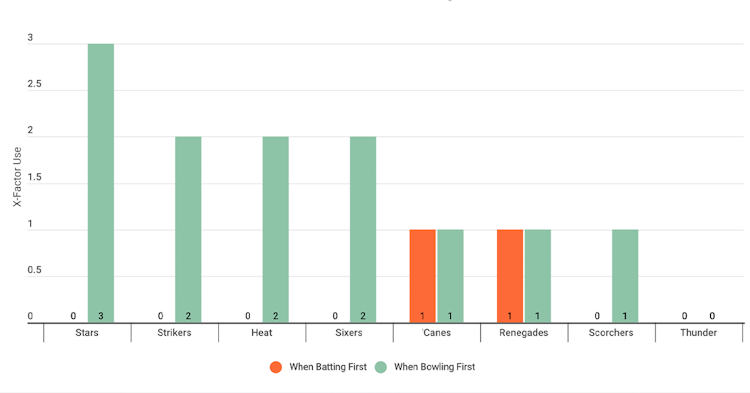BBL|10: Analysing The Effect Of The Competition's New Rules
Last updated: Jan 13, 2021, 6:20AM | Published: Jan 13, 2021, 12:18AM
TV commentary of every BBL|10 match has been full of discussion around the competition’s three new rules; the X-Factor, the Power Surge and the Bash Boost. But have they actually added anything beyond a talking point?
More than a month into BBL|10 and with a decent sample size of 37 matches, we decided it was time to look into the X-Factor and the Bash Boost, with an analysis of the Power Surge to come later in the week.
RELATED: Take a look at the updated Stats Insider BBL Futures Model
The X-Factor
The new concept of a super-sub or ‘X-Factor’ player has garnered plenty of chatter but across all 37 matches, (thus 74 opportunities) it’s only been utilised 13 times. In terms of a percentage, that’s only 17.5%, or less than one in five games by either side.
Ever more curiously, only on two of those 13 occasions when the X-Factor has been used has it been deployed by the side batting first.
Those games were both relatively early in the competition, and on both occasions those sides lost. The Hurricanes in Game 8 against the Strikers when batsman Mac Wright was introduced for bowler, and likewise in Game 10 when the Renegades brought in Mackenzie Harvey, (who didn’t actually bat) against the Hurricanes.
Ever since, there’s been a clear reluctance from the batting side to tinker with their line-up.
On two occasions, the X-Factor has been used due to injury, the Stars with Nic Maddinson,and the Scorchers more recently with Mitch Marsh.
That was Perth’s only use of the X-Factor, while the Thunder are yet to utilise it at all. The Renegades haven’t since their Harvey fail.
It took until the eighth game for the X-Factor to finally be deployed, on that occasion by both sides. Since then it’s been used on a relatively irregular basis by the bowling side, although from Games 23-31 it was used five times from nine opportunities by the bowling side, representing a trend of sorts.

RELATED: BBL to World Cup: From Little Things Big Things Grow
Bash Boost
The introduction of a Bash Boost bonus point for whomever is ahead in the game at the 10-over mark in the second innings has been another peculiar addition for BBL|10.
Those who’ve watched the broadcast will have heard plenty of discussion about it and it’s no surprise the side at the top of the table, the Sydney Sixers, have the most bonus points with 7. Interestingly, the third-placed Perth Scorchers have the equal fewest alongside the struggling Renegades with 3.
Perth’s recent success batting first has come with an initial slow run rate that's arguably has cost them bonus points, with coach Adam Voges arguing it’s a rule which favours the side batting first.
In reality, on 21 occasions the side batting second has won the bonus points, compared to 15 times for the side bowling second. One on occasion, the Stars-Scorchers no-result, no bonus point was awarded.
Beyond all that, if all the bonus points were wiped, and the ladder reverted back to BBL|09 style, where a win was worth 2 points and a no-result worth 1, then there’d only be one difference, with the two Sydney sides swapping places at the top based on net run rate.
Current BBL|10 ladder with bonus points
BBL|10 ladder based on BBL|09 points system
These introductions, along with the Power Surge which we’ll analyse later in the week, were introduced to add more intrigue and entertainment for the TV product, yet on the whole, the above data suggests their impact has been limited.
Whether that’ll impact the Sixers or the Thunder in their title charge remains to be seen, likewise whether the Scorchers will rue their lack of bonus points. We’ll wait and see.
Did you enjoy this article? Join our free mailing list to get the best content delivered straight to your inbox, or join the conversation by leaving a comment below or on the Stats Insider Twitter or Facebook page.



